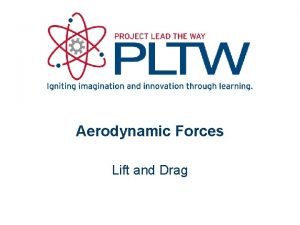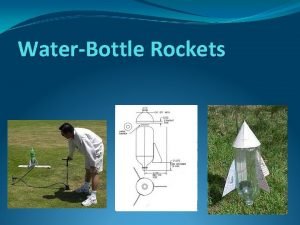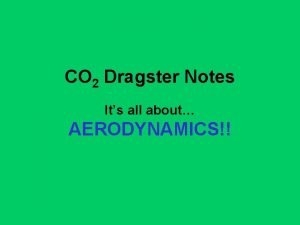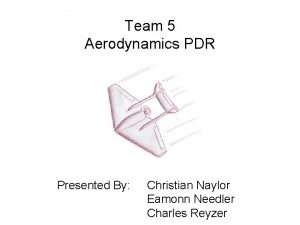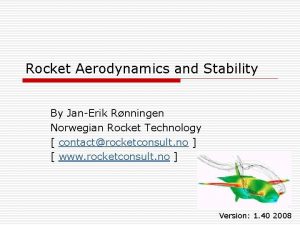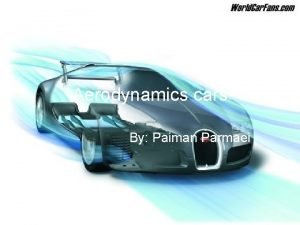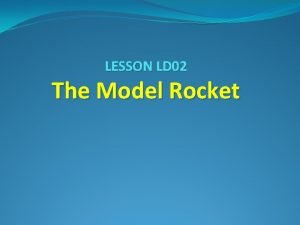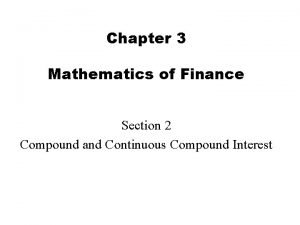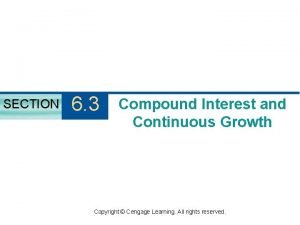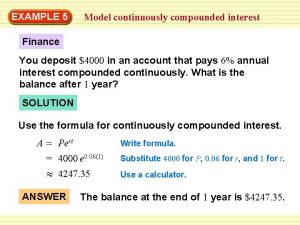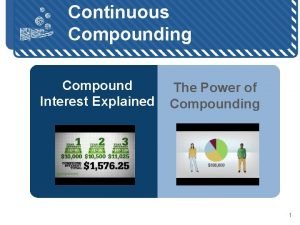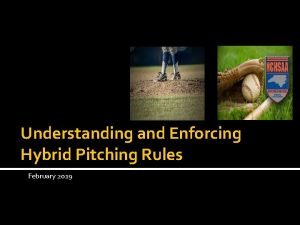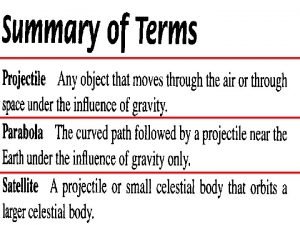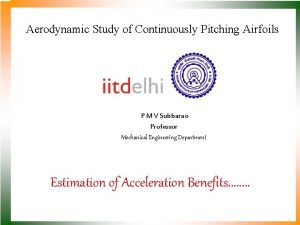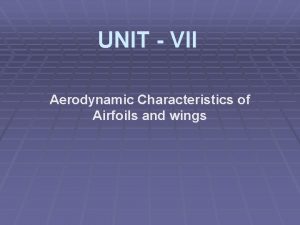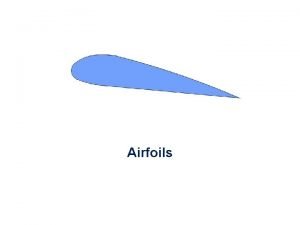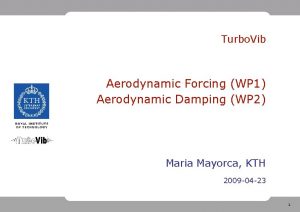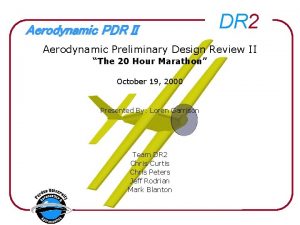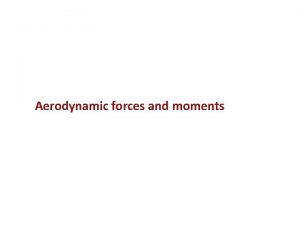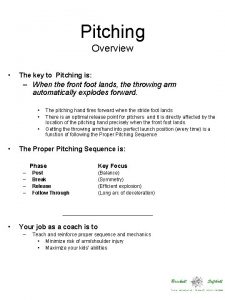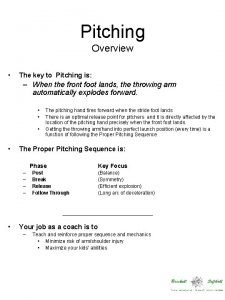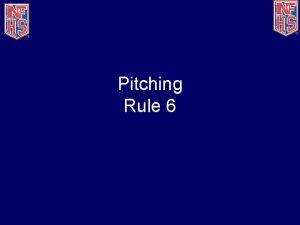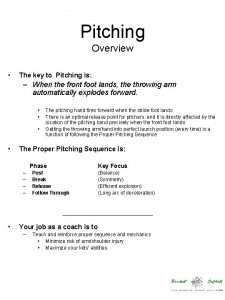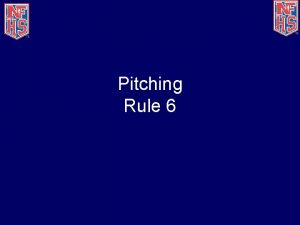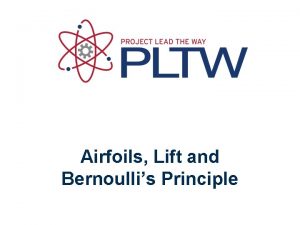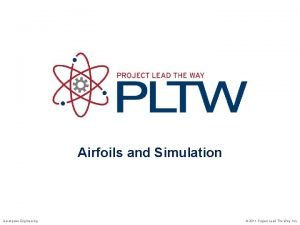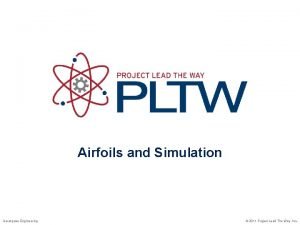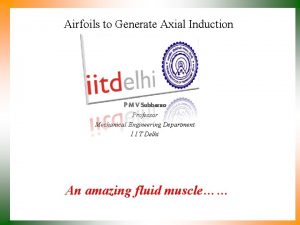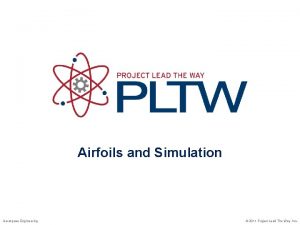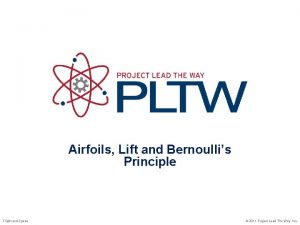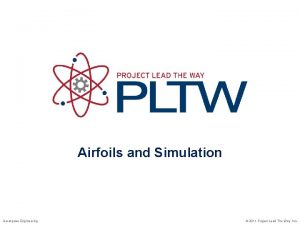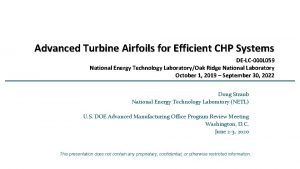Aerodynamic Study of Continuously Pitching Airfoils P M
























- Slides: 24

Aerodynamic Study of Continuously Pitching Airfoils P M V Subbarao Professor Mechanical Engineering Department Estimation of Acceleration Benefits. . . .

Aerodynamics of Unsteady Airfoil Motion • The flow phenomena associated with unsteady airfoil motion has been a major research focus for the past two decades. • Specific attention has been given to dynamic stall and its associated effects on the airfoil upper surface pressure field. • Flapping motion is the major mode of locomotion for the flying insects and birds, and the swimming of fish. • Birds and insects take advantage of the dynamic stall effects such as the high magnitude of unsteady lift to sustain their flights. • Flying animals achieve high manoeuvrability using unsteady wind motion. • 21 st century has directed the research attention towards airfoil pitching at constant rates to high angles of attack.

Static Vs Dynamic Lift Curves 5 4 Unsteady 3 2 1 6 Static

An Airfoil Pitching At Constant Pitch Rate : State 1: At the onset of rotation, the lift produced at zero angle of attack for the unsteady case is slightly larger as compared to that produced by the simple symmetric airfoil during steady state operation.

An airfoil pitching at constant pitch rates : state 2 State 2: As the angle of attack increases, the lift curve slope starts to decrease to some extent and a slight curvature is observed in the socalled linear region of the lift curve. As the steady-state stall angle of attack is exceeded, the airfoil continues to generate lift.

An Airfoil Pitching at Constant Pitch Rate: State 3: A slight kink or plateau is observed in the lift curve.

Pre-stall regime • For an airfoil undergoing constant pitch motions, the lift coefficient in the so-called ‘linear’ regime experiences some peculiar effects such as: • An increased lift at the onset of motion and a decreased slope of lift curve. • Lift curve attains a curvature before the formation of the DSV. • Afterwards, a slight kink is observed in the lift curve just prior to the formation of the DSV.

The Birth of Dynamic Stall Vortex • The thin reverse flow region rapidly transits from the trailing edge towards the leading edge of a pitching airfoil. • This event is considered to be the most fundamental precursor to the formation of the DSV. • This leads to sudden change in Suction Pressure • The increase in the suction pressures results in an instantaneous increase in the lift slope. Onset of Leading edge separation

The plateau The convection of the starting vortex over the airfoil induces large-scale disturbances in the attached boundary layer near the surface.

The Birth : The Primary Cause & Final Effect Onset of Leading edge separation Cp x/c

Evolution of Infant DSV Vortex build-up at the leading edge. Cp x/c

The Toddler Stage of DSV Detachment of leading edge vortex and onset of trailing edge vortex Cp x/c

The Teenager Stage of DSV Detachment of trailing edge vortex Cp x/c

Measurement of The Effect of Evolving DSV

Origin and Growth of Dynamic Stall Vortex Onset of Leading edge separation Detachment of leading edge vortex and onset of trailing edge vortex Vortex build-up at the leading edge. Detachment of trailing edge vortex

Impact of DSV: Introductory Remarks • The dynamic stall process of the flow over a constantly pitching airfoil is a classic example of unsteady separation. • It comprises a series of complex aerodynamic phenomena. • It features a lift overshoot and a delay in the onset of massive flow separation with respect to static stall. • The salient feature of the unsteady separating flow is the formation and convection of a large-scale coherent structure referred to as the dynamic stall vortex. • This most prominent example is observed on the retreating blades of a helicopter rotor in forward flight.

Role of Dynamic Stall vortex • The flow around the leading edge of the oscillating airfoil plays a key role in the development and shedding of a concentrated vortex known as the dynamic stall vortex. • The favorable effect of this vortex is the increase of lift during part of the cycle. • However, shedding of the vortex into the wake causes very large excursions in drag and pitching moment, which are undesirable effects.

Definition: The Dynamic Stall Vortex “A large vortex shed from the lead edge of the pitching wings and swirls around over the top of a pithing airfoil is defined as Dynamic Stall Vortex (DSV). DSV creates a suction region, a low pressure that can act to increase drag and lift.

Flow structures around NACA 0012 airfoil at an angle of attack of 50 Re = 6700 Re = 12000 Re = 21000

An Airfoil Pitching at Constant Pitch Rates : State 4: With further increase in the angle of attack, the lift curve slope is observed to increase. This is the stage at which the primary DSV is observed.

An airfoil pitching at constant pitch rates : state 5 State 5: The airfoil experiences complete flow separation and there is a sudden decrease in the lift indicating the occurrence of dynamic stall.

An airfoil pitching at constant pitch rates : state 6 State 6: The airfoil continues to generate lift beyond dynamic stall if pitching is continued. The post-stall lift characteristics during the foil rotation are still superior compared to the steady-state lift characters.

The Stall Region • After its inception, the DSV, under the influence of the freestream flow, convects over the surface of the airfoil. • This motion induces a complex, non-linear pressure field. • The convection of the vortex is also associated with a discontinuous change in circulation over the airfoil. • As the vortex moves downstream, the forces and moments generated by the airfoil reach their respective maximum values, • Finally, the DSV departs the vicinity of the airfoil, leading to large scale flow separation. • The airfoil is now under a state of complete unsteady stall. • The convection of the DSV from the airfoil surface causes a rapid decrease in the lift of the airfoil.

Control of Stall Effects
 Equation for drag
Equation for drag Water rocket simulator
Water rocket simulator Aerodynamic dragster
Aerodynamic dragster Mean aerodynamic chord
Mean aerodynamic chord Aerodynamic shapes
Aerodynamic shapes Missile aerodynamics
Missile aerodynamics Aerodynamic devices
Aerodynamic devices Least aerodynamic shape
Least aerodynamic shape Example of annual percentage rate
Example of annual percentage rate How to write compound interest formula
How to write compound interest formula Which term is used to describe bitmap images
Which term is used to describe bitmap images Continuously compounded interest
Continuously compounded interest What does continuously monitoring internal marketing
What does continuously monitoring internal marketing Pert formula compound interest
Pert formula compound interest Jennie finch pitching video slow motion
Jennie finch pitching video slow motion Hybrid windup baseball
Hybrid windup baseball 2019 nfhs baseball exam
2019 nfhs baseball exam Wiaa rule book
Wiaa rule book A ball player wishes to determine pitching speed
A ball player wishes to determine pitching speed Ecological study vs cohort study
Ecological study vs cohort study Phytogeographical regions of world
Phytogeographical regions of world Retrospective cohort study
Retrospective cohort study Difference between time study and motion study
Difference between time study and motion study Work study and method study
Work study and method study Differentiate between time study and motion study
Differentiate between time study and motion study
